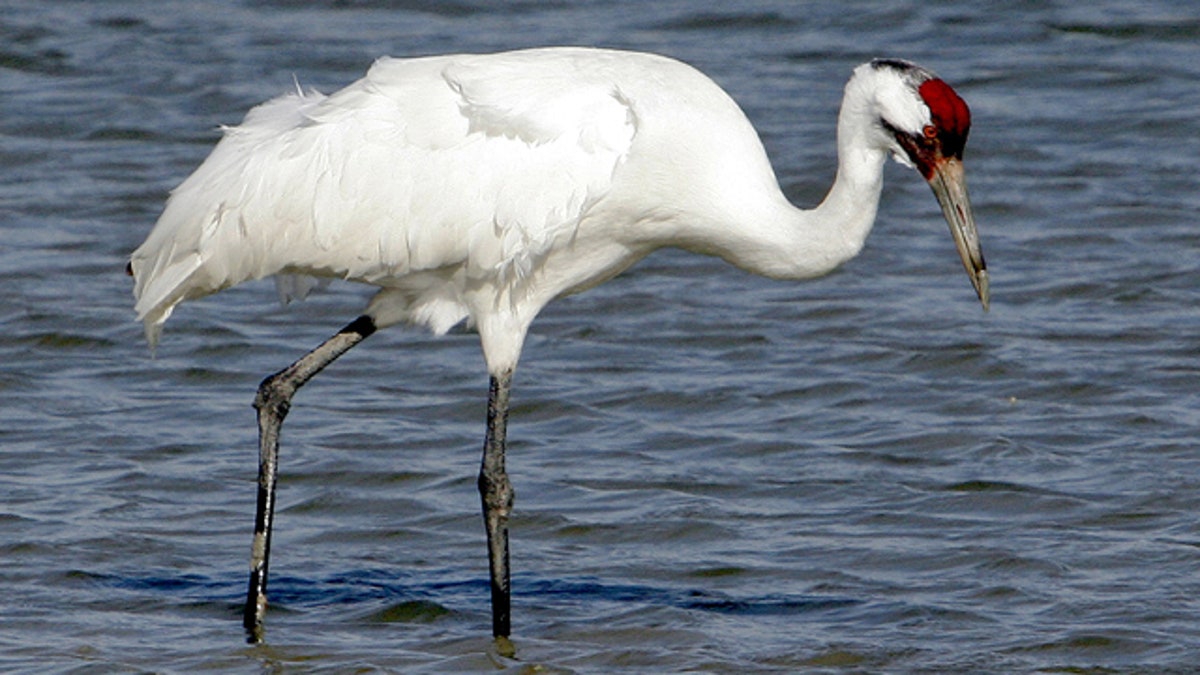
In this Jan. 15, 2006 file photo, a whooping crane searches for food at the Aransas National Wildlife Refuge near Rockport, Texas. (AP)
NEW ORLEANS – The whooping crane — one of the world's most endangered birds and one of the first animals on the U.S. endangered list — could be back in Louisiana's wetlands as early as February under a U.S. Fish and Wildlife Service proposal.
The long-legged birds with the distinctive call haven't lived in the wild in Louisiana since 1950.
Under the plan, young birds would be released into a pen about 125 miles west of New Orleans in Louisiana's bayou country after they are raised by people wearing shapeless white "crane suits."
It's an area where whooping cranes once lived and raised young.
The birds will eventually be able to fly out, but likely will remain in the area because whooping cranes must be taught to migrate, Bill Brooks, a biologist with the U.S. Fish and Wildlife Service said Wednesday.
"I'm excited. You can't imagine," said Mary Lynch Courville, whose federal biologist father, John J. Lynch, captured the last wild whooping crane alive in Louisiana and took it to join a Texas flock in 1950. She has been campaigning for a quarter-century to return whooping cranes to the wild in Louisiana.
Standing about 5 feet high, whooping cranes are the tallest birds in North America.
They once ranged from the Arctic to central Mexico's high plateau, and from Utah east to New Jersey, South Carolina and Florida, according to the proposal published Thursday in the Federal Register. Never abundant, they were hunted for plumage and taxidermy, and their habitats were converted to hayfields, pastures and grain farms. Their numbers plummeted from an estimated 500 to 700 in 1870 to 16 migrating birds in 1941.
Nearly 550 whooping cranes are now alive: just under 400 in the wild and nearly 150 at breeding and rearing facilities including the Audubon Center for Research of Endangered Species just outside New Orleans. All of them are descended from 15 birds.
The only self-sustaining wild flock of whooping cranes migrates between Wood Buffalo National Park in the Northwest Territories of Canada and Aransas National Wildlife Refuge in Texas. One smaller flock migrates between Wisconsin and Florida, and a second lives in Florida year-round.
The Louisiana Department of Wildlife and Fisheries is "doing all the legwork" such as figuring out the best spot for the pen and building it, Brooks said.
He said the proposed site is remote from people, away from trees and shrubs so the cranes can see far into the distance, and has lots of shallow water for the cranes to roost. They sleep standing in the water, he said.
"If they're roosting in water there's a much better chance of hearing a predator such as a bobcat or coyote coming through the water," Brooks said.
Brooks said biologists hope to release eight young birds next year and up to 30 a year for 10 more years.
The Fish and Wildlife Service is asking for public comment on the proposal.

